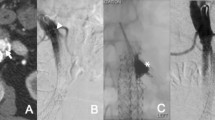Abstract
Abdominal endovascular aneurysm repair (EVAR) and thoracic endovascular aneurysm repair (TEVAR) have changed the aortic surgery, due to several advantages in terms of reduced morbidity and mortality. However, increasing rate of late complications requiring secondary procedures has been observed over time. Even if the majority of them may be treated by means of endovascular techniques, late open surgical conversion (LOSC) is required in specific situations. This paper aims to provide our single-center experience with LOSCs and an updated review of the literature. From 1995 to 2020, indications and outcomes of patients treated with LOSC for failed EVAR and TEVAR, at our institutions, were analyzed. LOSC was required to treat a broad range of complications that were classified into two main groups: “disease related” and “stent-graft (SG) related.” Among the 121 patients treated with LOSC after EVAR, endoleak (75.2%) represented the most common indication. The overall 30-day mortality rate was 3.3%. A higher mortality rate was associated with infection after EVAR (p. 006). Among the 81 patients treated with LOSC after TEVAR, endoleak (32.1%) was the most common indication. The overall 30-day mortality rate was 13.6% with a higher incidence in the SG-related group (p. 02). LOSC is associated with an increased surgical complexity, in both the abdominal and thoracic area, that results in higher morbidity and mortality rates compared with standard open repair. Depending on the indication to LOSC, specific surgical maneuvers are required to improve clinical outcomes.






Similar content being viewed by others
References
Parodi JC, Palmaz JC, Barone HD. Transfemoral intraluminal graft implantation for abdominal aortic aneurysms. Ann Vasc Surg. 1991;5(6):491–9.
Stather P, Sidloff D, Dattani N, et al. Systematic review and meta-analysis of the early and late outcomes of open and endovascular repair of abdominal aortic aneurysm. Br J Surg. 2013;100(7):863–72.
Vallabhaneni SR, Harris P. Lessons learnt from the EUROSTAR registry on endovascular repair of abdominal aortic aneurysm repair. Eur J Radiol. 2001;39(1):34–41.
Czerny M, Grimm M, Zimpfer D, et al. Results after endovascular stent graft placement in atherosclerotic aneurysms involving the descending aorta. Ann Thorac Surg. 2007;83:450–5.
Kuratani T, Sawa Y. Current strategy of endovascular aortic repair for thoracic aortic aneurysms. Gen Thorac Cardiovasc Surg. 2010;58:393–8.
Zhang L, Zhao Z, Chen Y, et al. Reintervention after endovascular repair for aortic dissection: a systematic review and meta-analysis. J Thorac Cardiovasc Surg. 2016;152:1279–88.
De Bruin JL, Baas AF, Buth J, et al. DREAM study group. Long-term outcome of open or endovascular repair of abdominal aortic aneurysm. N Engl J Med. 2010;362(20):1881–9.
Kouvelos G, Koutsoumpelis A, Lazaris A, et al. Late open conversion after endovascular abdominal aortic aneurysm repair. J Vasc Surg. 2015;61(5):1350–6.
Szeto WY, Desai ND, Moeller P, et al. Reintervention for endograft failures after thoracic endovascular aortic repair. J Thorac Cardiovasc Surg. 2013;145:S165–S170170.
Canaud L, Alric P, Gandet T, et al. Open surgical secondary procedures after thoracic endovascular aortic repair. Eur J Vasc Endovasc Surg. 2013;46:667–74.
Ultee KH, Soden PA, Zettervall SL, et al. Conversion from endovascular to open abdominal aortic aneurysm repair. J Vasc Surg. 2016;64(1):76–82.
Spanos K, Rohlffs F, Panuccio G, et al. Outcomes of endovascular treatment of endoleak type Ia after EVAR: a systematic review of the literature. J Cardiovasc Surg (Torino). 2019;60(2):175–85.
Ultee KHJ, Büttner S, Huurman R, et al. Editor’s choice-systematic review and meta-analysis of the outcome of treatment for Type II Endoleak following endovascular aneurysm repair. Eur J Vasc Endovasc Surg. 2018;56(6):794–807.
Girdauskas E, Falk V, Kuntze T, et al. Secondary surgical procedures after endovascular stent grafting of the thoracic aorta: successful approaches to a challenging clinical problem. J Thorac Cardiovasc Surg. 2008;136(5):1289–94.
Coselli JS, Spiliotopoulos K, Preventza O, et al. Open aortic surgery after thoracic endovascular aortic repair. Gen Thorac Cardiovasc Surg. 2016;64:441–9.
Dong Z, Fu W, Wang Y, Wang C, Yan Z, Guo D, et al. Stent graft-induced new entry after endovascular repair for Stanford type B aortic dissection. J Vasc Surg. 2010;52(6):1450–7.
Bonvini S, Wassermann V, Menegolo M, et al. Surgical infrarenal "neo-neck" technique during elective conversion after EVAR with suprarenal fixation. Eur J Vasc Endovasc Surg. 2015;50(2):175–80.
Bendermacher BL, Stokmans R, Cuypers PW, et al. EVAR reintervention management strategies in contemporary practice. J Cardiovasc Surg (Torino). 2012;53(4):411–8.
Kahlberg A, Rinaldi E, Piffaretti G, et al. Results from the multicenter study on aortoenteric fistulization after stent grafting of the abdominal aorta (MAEFISTO). J Vasc Surg. 2016;64(2):313–20.
Tshomba Y, Kahlberg A, Melissano G, Coppi G, Marone E, Ferrari D, Lembo R, Chiesa R. Comparison of renal perfusion solutions during thoracoabdominal aortic aneurysms repair. J Vasc Surg. 2014;59:623–33.
Melissano G, Tshomba Y, Mascia D, et al. Late open conversion after TEVAR. J Cardiovasc Surg (Torino). 2016;57(4):491–7.
Kahlberg A, Grandi A, Loschi D, et al. A systematic review of infected descending thoracic aortic grafts and endografts. J Vasc Surg. 2019;69(6):1941–1951.e1.
Lopes JA, Jorge S. The RIFLE and AKIN classifications for acute kidney injury: a critical and comprehensive review. Clin Kidney J. 2013;6:8e14.
Choi K, Han Y, Ko GY, et al. Early and late outcomes of endovascular aortic aneurysm repair versus open surgical repair of an abdominal aortic aneurysm: a single-center study. Ann Vasc Surg. 2018;51:187–91.
Gopaldas RR, Huh J, Dao TK, et al. Superior nationwide outcomes of endovascular versus open repair for isolated descending thoracic aortic aneurysm in 11,669 patients. J Thorac Cardiovasc Surg. 2010;140(5):1001–100.
Sylvestre R, Coscas R, Javerliat I, et al. Eligibility rates for ambulatory EVAR. Ann Vasc Surg. 2019;58:7–15.
Li B, Khan S, Salata K, Hussain MA, et al. A systematic review and meta-analysis of the long-term outcomes of endovascular versus open repair of abdominal aortic aneurysm. J Vasc Surg. 2019;70(3):954–969.e30.
Biancari F, Mariscalco G, Mariani S, et al. Endovascular treatment of degenerative aneurysms involving only the descending thoracic aorta: systematic review and meta-analysis. J Endovasc Ther. 2016;23(2):387–92.
Turney EJ, Steenberge SP, Lyden SP, et al. Late graft explants in endovascular aneurysm repair. J Vasc Surg. 2014;59(4):886–93.
Mohapatra A, Robinson D, Malak O, et al. Increasing use of open conversion for late complications after endovascular aortic aneurysm repair. J Vasc Surg. 2019;69(6):1766–75.
Joo HC, Kwon JH, Kim JH, et al. Late open conversion after thoracic endovascular aortic repair. J Vasc Surg. 2019;70(2):439–48.
Fairman AS, Beck AW, Malas MB, et al. Reinterventions in the modern era of thoracic endovascular aortic repair. J Vasc Surg. 2020;71(2):408–22.
Perini P, Gargiulo M, Silingardi R, et al. Late open conversions after endovascular abdominal aneurysm repair in an urgent setting. J Vasc Surg. 2019;69(2):423–31.
Keschenau PR, Ketting S, Mees B, et al. Open thoracic and thoraco-abdominal aortic repair after prior endovascular therapy. Eur J Vasc Endovasc Surg. 2018;56(1):57–67.
Riambau V, Böckler D, Brunkwall J, et al. Management of descending thoracic aorta diseases: clinical practice guidelines of the European society for vascular surgery (ESVS). Eur J Vasc Endovasc Surg. 2017;53(1):4–52.
Wanhainen A, Verzini F, Van Herzeele I, et al. European society for vascular surgery (ESVS) 2019 clinical practice guidelines on the management of abdominal aorto-iliac artery aneurysms. Eur J Vasc Endovasc Surg. 2019;57(1):8–93.
Marone EM, Mascia D, Coppi G, et al. Delayed open conversion after endovascular abdominal aortic aneurysm: device-specific surgical approach. Eur J Vasc Endovasc Surg. 2013;45(5):457–64.
Harky A, Zywicka W, Santoro G, et al. Is contrast-enhanced ultrasound (CEUS) superior to computed tomography angiography (CTA) in detection of endoleaks in post-EVAR patients? A systematic review and meta-analysis. J Ultrasound. 2019;2(1):65–75.
White HA, Macdonald S. Estimating risk associated with radiation exposure during follow-up after endovascular aortic repair (EVAR). J Cardiovasc Surg (Torino). 2010;51(1):95–104.
Silverberg D, Aburamileh A, Rimon U, et al. Secondary interventions after fenestrated and branched endovascular repair of complex aortic aneurysms. J Vasc Surg. 2020;72(3):866–72.
Funding
This study was not supported by any funding.
Author information
Authors and Affiliations
Corresponding author
Ethics declarations
Conflict of interest
The authors declare that they have no conflict of interest.
Consent for Publication
Consent for publication was obtained for every individual person’s data included in the study.
Human and Animal Rights
All procedures performed in studies involving human participants were in accordance with the ethical standards of the institutional and/or national research committee and with the 1964 Helsinki Declaration and its later amendments or comparable ethical standards.
Informed Consent
Informed consent was obtained from all individual participants included in the study.
Additional information
Publisher's Note
Springer Nature remains neutral with regard to jurisdictional claims in published maps and institutional affiliations.
Electronic supplementary material
Below is the link to the electronic supplementary material.
Rights and permissions
About this article
Cite this article
Rinaldi, E., Kahlberg, A., Carta, N. et al. Late Open Conversion Following Failure of EVAR and TEVAR: “State of the Art”. Cardiovasc Intervent Radiol 43, 1855–1864 (2020). https://doi.org/10.1007/s00270-020-02636-w
Received:
Accepted:
Published:
Issue Date:
DOI: https://doi.org/10.1007/s00270-020-02636-w




